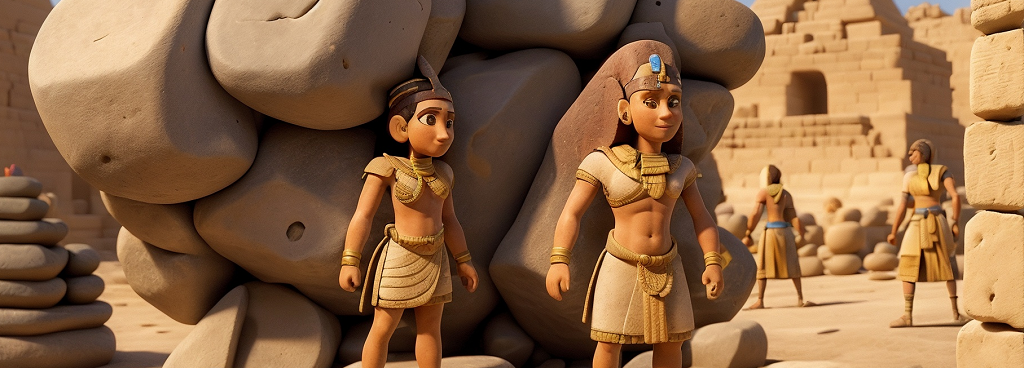Pharaoh Khufu reclined on his golden throne as Grand Vizier Hemiunu unfurled the architectural plans with a flourish. “Behold your magnificence! The grandest pyramid conceived by man! Its dimensions are precisely calculated using the latest geometric techniques.”
Khufu studied the papyrus plans, stroking his royal beard. “And how long until its completion?”
Hemiunu bowed low. “We estimate around 20 years, your excellence. We must hand-chisel over two million limestone blocks, each transported and positioned with utmost care.”
Khufu bolted upright. “20 years? Far too long for a living god to wait!”
“A thousand apologies, my king,” Hemiunu stammered, averting his eyes from Khufu’s fiery gaze. “We could attempt to scale down—”
Khufu raised one hand to silence his groveling vizier. “No. I desire it to be larger and grander than any monument before! But such a schedule cannot stand.”
He rose from his gilded throne and began pacing the royal chamber, each step echoing off the expansive sandstone walls. Hemiunu kept his eyes lowered, sweat beading on his shaved head as he awaited his fate.
After several tense moments, Khufu halted and turned toward the entrance. “Summon Vizier Paneb at once!” His voice boomed through the hall.
Moments later, Paneb entered and fell to his knees. “You called, your excellence?”
Khufu wasted no time. “Paneb, make me a pyramid to dwarf all others! But do it faster than this fool’s plan, or you will only deepen my dissatisfaction.”
Paneb raised his eyes. “Your greatness, I believe I can succeed where Hemiunu failed. There are…alternative methods.”
Khufu slowly returned to his throne, intrigued. “Go on.”
Paneb chose his next words carefully. “Great Pharaoh, have you heard of something called…Agile?”
“Agile is a new method gaining favor among builders,” Paneb explained. “It emphasizes flexibility, collaboration, and continuous improvement.”
Khufu leaned forward, gesturing for him to continue.
“We organize workers into small teams, each focused on tasks in short bursts called sprints,” said Paneb.
“Teams plan only weeks ahead, starting small, gathering feedback, and improving incrementally.”
Paneb unfurled a papyrus scroll. “Daily scrum meetings ensure open communication and progress.”
He pointed to a drawing of an unfinished pyramid. “Work is evaluated at the end of each sprint and plans are adjusted.”
Khufu nodded, intrigued by this flexible approach.
“As Pharaoh, you can review work after each sprint and request changes,” Paneb said. “Agile empowers you to reshape your vision continuously.”
Walking toward the throne, Paneb concluded, “With Agile, the finish date is uncertain. But there will come a point where you are satisfied with the monument to shift resources to new projects.”
“You will see visible progress in months, not decades.”
He dropped to one knee before the throne. “I believe Agile can unlock innovation like never before. That is, with your wisdom to lead the way, great Pharaoh.”
A slow smile spread across Khufu’s face. “Bold claims, Paneb. Very well, build my pyramid using this ‘Agile’ approach. But deliver tangible results swiftly, or you will deeply regret it.”
Paneb bowed low. “Thank you, your excellence. You will not be disappointed!”
Vizier Paneb organized the Hebrew stonecutters into agile teams. They toiled through lunar cycles, working in alignment with the phases of the moon, quarrying limestone blocks and hauling them to the pyramid site.
After each sprint, Paneb presented their progress to Pharaoh Khufu for feedback. “Behold the newest increments, your excellence!” Khufu enjoyed revising plans on a whim, reshaping his vision sprint by sprint.
But haste bred shoddy craftsmanship. Foundations collapsed under added weight, requiring perpetual reinforcement.
Before each sprint planning, Paneb led laborious estimation sessions. “How many stones this cycle?” Debates raged for hours until reaching consensus. But actual progress never matched estimates.
Five years passed in this manner. Little measurable progress had been made. The structure resembled little more than a shapeless, crumbling hill of rock.
Khufu finally summoned Paneb, enraged. “This agile approach has cost me years of toil with no results!”
Paneb fell to his knees. “A thousand apologies, my king! Please, give me one more chance…”
Khufu slammed his fist. “Enough! I have indulged this folly too long. Bring me new architects at once!”
Dejected, Paneb relinquished oversight of the project. The pyramid was eventually completed using traditional methods. Though it required decades more labor, slaves dying by the thousands, the monument at last reached majestic heights to honor Khufu’s reign.
As for agile techniques, they were forgotten for generations in Egypt after this failure. None dared mention the disgraced methodology again in Pharaoh Khufu’s lifetime or for long after.
But centuries later, an ancient papyrus scroll was discovered in the ruins of a pyramid. It contained strange diagrams and philosophies. “Respond to change over following a plan…”
Word spread of these unearthed agile principles. They found new life, transforming software design and business management millennia after Paneb’s futile attempt.
For good ideas hold enduring appeal, even when premature or poorly practiced. The seeds may lie dormant for ages awaiting the right conditions to bloom. Though the pyramid could not be agilized, agile itself could not be buried forever.
Disclaimer: This post was generated with assistance of multiple large language models (LLM), including Claude (text), ChatGPT (feedback), and Leonardo (image). It also involved limited research by the author into the actual construction of the pyramid from publicly available sources such as Wikipedia. No efforts have been made to ensure accuracy and relevance of the information presented. The information, including historical events and construction details of the pyramid, may be subject to interpretation and is guaranteed to be inaccurate. Readers are strongly encouraged to use critical judgment, verify information independently, and consult reliable historical and scholarly sources for precise and accurate information about historical events or other topics.

